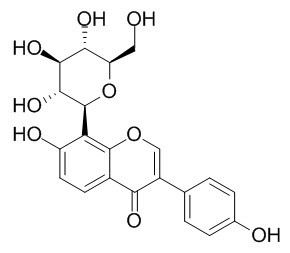Natural Products
Puerarin
| Catalog No. | CFN99169 |  |
| CAS No. | 3681-99-0 | |
| Molecular Weight: | 416.38 | |
| Molecular Formula | C21H20O9 | |
| DBs | [PubChem]:274951249 [ChEMBL]:8633 [PCIDB]:6094 |
Standard InChI:
InChI=1S/C21H20O9/c22-7-14-17(26)18(27)19(28)21(30-14)15-13(24)6-5-11-16(25)12(8-29-20(11)15)9-1-3-10(23)4-2-9/h1-6,8,14,17-19,21-24,26-28H,7H2/t14?,17-,18+,19?,21+/m1/s1
Biological Activity
Puerarin is the most abundant of flavonoid derivatives in the root of Pueraria lobata (Willd) Ohwi, has antioxidant activity and can impair CYP-catalysed drug metabolism.[1]
Puerarin can reduce the atherogenic properties of dietary cholesterol in rats, the hypocholesterolemic function may be due to the promotion of cholesterol and bile acids excretion in liver. [2]
Puerarin could inhibit oxidative stress through the activation of phosphatidylinositol 3-kinase (PI3K)-Akt pathway, could significantly reduce traumatic brain injury (TBI)-induced neuronal degeneration, accompanied by the partial restoration of the redox disturbance and enhanced expression of phospho-Akt in the pericontusional cortex after TBI.[3]
Puerarin may act as an intracellular ROS scavenger, and its antioxidant properties may protect against Abeta25-35-induced cell injury,and apoptosis and could also promote the survival of PC12 cells.[4]
Puerarin can ameliorate Aβ(1-42)-induced and reverse the increase of in the hippocampus, the attenuation is associated with the activation of and of Bad, suggests that puerarin may be an anti-candidate drug to suppress both -related neuronal cell and dysfunction of the system.[5]
Product
References
[1] Guerra M C, Speroni E, Broccoli M, et al. Life Sci, 2000, 67(24):2997-3006.
[2] Yan L P, Chan S W, Chan S C, et al. Life Sci, 2006, 79(4):324-30.
[3] Wang J W, Wang H D, Cong Z X, et al. J Surg Res, 2014, 186(1):328-37.
[4] Hai-YingZhang, Yi-Heng Liu, Hong-Quan Wang, et al.Cell Biol Int,2008, 32(10):1230-7.
[5] Li J, Wang G, Liu J, et al. Eur J Pharm, 2010, 649(1-3):195–201.
[6] Peng Z B, Fan Y B, Tang W F. World Journal of Integrated Traditional & Western Medicine, 2009, 4(07):480-2.
Product Use Citation





